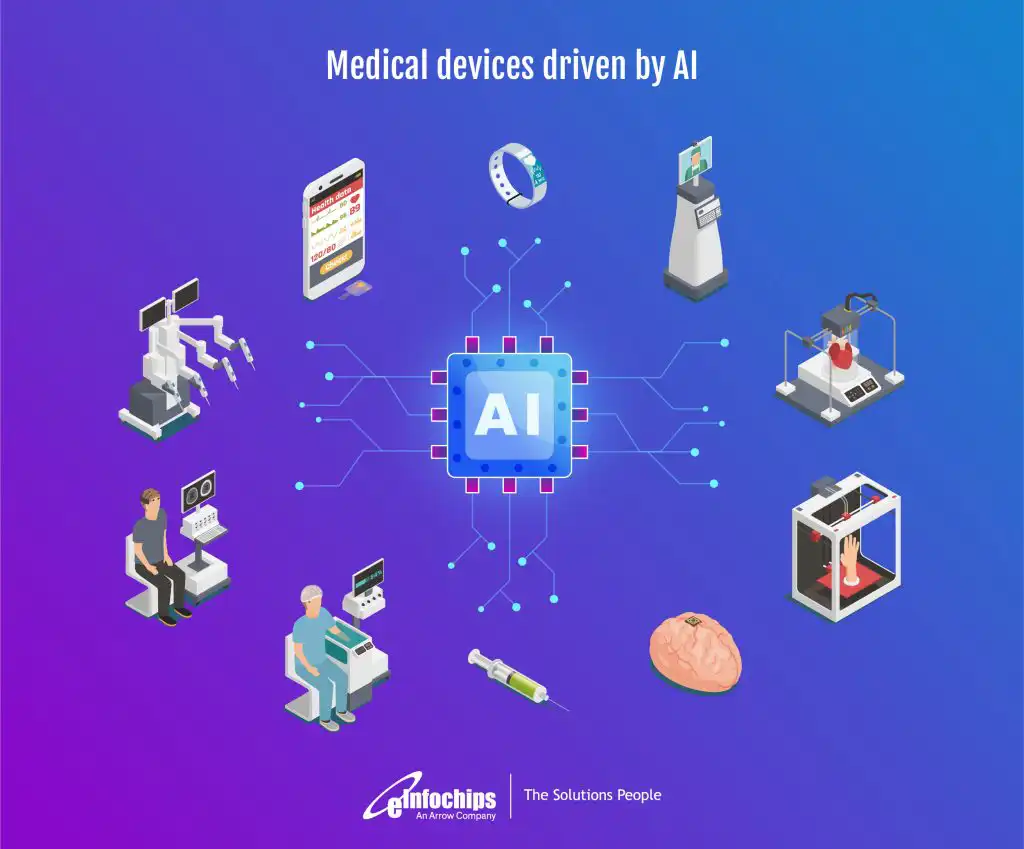It is pretty much clear that 2024 is going to be a year when the medical device industry is going to set up a tone for the next 5 -10 years. For example, AR-VR Health Care market, which stood at USD2.5 billion in 2022, is now expected to grow with a CAGR of 18.8% for 2023-2030.
While the pandemic has certainly helped the medical industry create a demand of advanced IoT and AI/ML based devices and add a new revenue stream, it has also helped in accelerating the advancements of the early detection systems to ensure that the essentials of personal medical care are not stripped away.
Here are some key advancements to look for in the medical devices industry in 2024
- Development and use of smart devices is going to gain popularity across various use cases for personal healthcare resulting in more capable and intelligent devices. The global smart medical devices market is expected to expand globally at a compound annual growth rate (CAGR) of 10.33%, from US$136 billion in 2021 to US$271 billion in 2028.
- The accessibility, awareness, and knowledge of the user to augment analytics, data and trends will witness a drastic shift with the increase in adaptation of the augmented devices
- Proactive healthcare approaches are expected to become more popular, and there will be a major shift from the reactive approach to proactive healthcare approaches that promote the preventive steps to detect any possibilities of illness or disease before it becomes untreatable
- Awareness of the effective and efficient use of medical devices at home has increased, leading to improved quality of life for individuals. The increased awareness has also led to a higher adoption of personal health systems by numerous people.
- As devices become more intelligent and responsive, users will be able to proactively and efficiently monitor their individual health through wearables. For example, medical devices product development companies are looking to incorporate specific functionalities in the wearables to detect the risks of depression by tracking the physical indicators.
Below are some medical device trends to note in 2024 across various medical subsegments with revenue specifically focused on growth within diagnostics
3D Printing
3D printing in medical devices is another booming market which is transforming the medical device manufacturing process. 3D printing helps in enabling the fabrication of customized implants, prosthetics, and surgical equipment with exceptional accuracy. The medical industry has used 3D printing significantly for creating patient related solutions, surgical planning, and orthopedic implants etc.
The market for 3D printing medical devices is expected to rise at a compound annual growth rate (CAGR) of 17.3% over the course of the forecast period, from $1.7 billion in 2022 to $5.9 billion by 2030, according to Global Industry Analysts.
Medical Robots
Robotic surgeries have become widely popular and are accelerating the trend of using robots in critical healthcare. For example, “Da-Vinci-Surgical System”- a surgical robot, is currently being used to assist medical professionals in the operating room. It certainly provides intelligent collaborative support for surgeons in complex surgeries. With advancements in robotic technology, surgical robots are also becoming more capable of performing procedures beyond standard programming.
Genomic Medicine
Genomic medicine is an interdisciplinary medical field in which genomic information about the patient is utilized to make informed decisions regarding their medical care. It leverages machine learning and artificial intelligence to formulate a patient care plan based on the specific needs of the patient. Genomic medicine is a futuristic solution approach and will continue to be used in various medical cases including pharmacology and oncology.
Medical Device Product Development Around Genomic Medicine can help medical professionals better understand the disease and provide more effective treatment solutions. This personalized treatment is being used currently in cancer and lung disorders among other conditions.
Computer Vision
Computer vision technology has applications in both hardware and software domains. With the advancement of this technology, the capabilities of devices will continue to improve, including the ability to provide crucial information by analyzing and interpreting images.
Computer vision as a technology has been around for quite a good time. However, the latest advancements have a key role to play in the upcoming medical device trends. For example, computer vision can help identify if the patient has a tumor and if it is hemorrhaging. It can be used in organically improving the accuracy of diagnosis of some critical illnesses.
Software as a medical device (SaMD)
SaMD can empower patients by providing access to their medical history through direct device connectivity, enabling them to better manage their personal health. For example, a patient with chronic medical condition can use the information from his personal health device to share it with medical practitioner to make better health decisions.
Extended Reality
Extended reality will involve some combination of AR, VR, and MR to train surgeons and medical students. Medical devices powered by virtual reality can benefit patients with vision problems, autism or even depression. It can even help with the issues of brain discordance while abstaining the patient from feeling any type of pain.
Enhanced Cybersecurity
With technological advancements, cyber threats have also increased, and the new breed of cyberterrorism is daunting. Thus, enhancements in cybersecurity practices are much needed across various areas of the healthcare industry including medical device product development process and the device itself.
Healthcare data exchange among manufacturers, healthcare service providers, and suppliers needs to be well protected from potential vulnerabilities. The FDA is actively monitoring the way medical equipment manufacturers handle data security, making enhancements in cybersecurity a key trend in the medical device industry in the coming years.
Medical devices driven by AI
AI (Artificial Intelligence) will continue to rise as an integral part of the new medical device software for the extended use of gaining and analyzing information from smart and connected healthcare devices, point-of-care devices, and IoT (Internet of Things) systems.
The global artificial intelligence in healthcare market size was estimated at USD 20.9 billion in 2024 and it expecting to reach at USD 148 billion by 2029, with a CAGR of 48.1% in the forecast period.
Remote diagnostic, telemedicine and the continued risk of virus migration have increased demand for healthcare systems that involve minimum human touch. Artificial Intelligence and machine learning are now expected to be integrated into most medical devices as the data from these products can provide insights to aid decision-making for the future across the healthcare spectrum.
FDA has released guidelines on AI and Software as a Medical Device (SaMD) as the advent of AI & ML (Machine Learning) have the potential to reform the proactive healthcare approach by deriving right insights from the captured data.
Are you prepared for these medical device trends that are going to be reshaping the future of medical device industry in the upcoming years?
The advancement of technology has already begun to transform the medical devices industry across the globe. Companies are continuing to invest and implement these cutting-edge technologies in their upcoming medical device products and their development process to meet the needs of patients. There is plenty to look beyond in the medical devices market.
However, there will be many challenges in the future to address. While focusing on incorporating the modern technology trends in medical devices, it is more important to build strong partnerships that can help your business take full advantage of the current shift. From early design development and manufacturing to support after the product hits the market, a strong technology partner can help add capabilities that empower your business to move faster and rule a highly competitive market.
If you are not sure what that kind of partnership your business needs or how it will look, reach out to the team at eInfochips. As an innovation partner, we have engaged with many Fortunes 500 medical equipment companies and helped them with the expertise for services like concept to prototype development, value engineering and certification support.
Here’s a case study – Connected Cloud Platform for Ophthalmic Device (einfochips.com) that you can read and understand how eInfochips leverages forward-looking technologies to help its clients in modern medical device product development.













